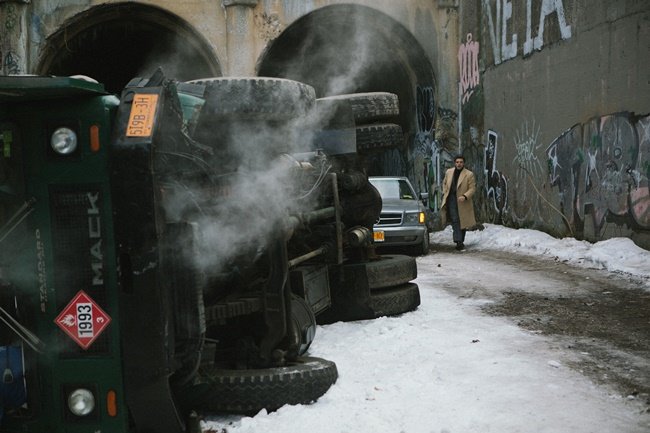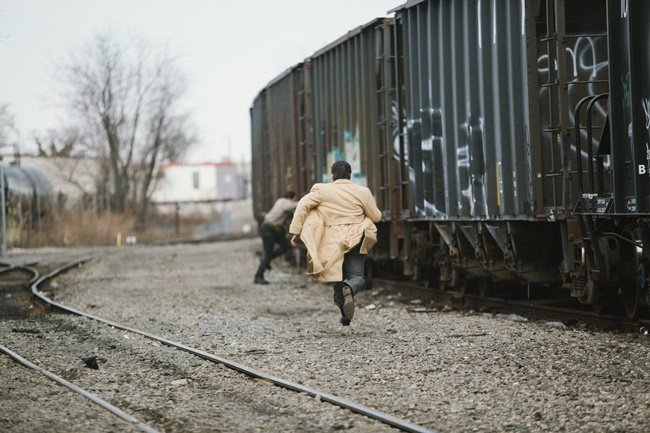
A Most Violent Year, director J.C. Chandor’s third feature after Margin Call (2011) and All is Lost (2013), packs an unsentimental punch: It unfolds over three wintry months in New York City of 1981, when the city’s crime statistics were at an all-time high.
The film stars Oscar Isaac and Jessica Chastain as Abel and Anna Morales, who together head a heating oil company that services the city—a cutthroat business. The Morales are looking to expand their share of the market while keeping one step ahead of both the law and their competition (whose rather unscrupulous practices aren’t too far a cry, perhaps, from the Morales’ own).
Chandor is proving to be a moviemaker for whom every new project can accurately be described as “a departure.” This dark, old-school crime thriller has precious few similarities with the luminously experimental All is Lost, and while it shares Margin Call‘s ensemble strengths and capitalist themes, the films are entirely different visual experiences. Here, Chandor explains how he and his team, led by DP-of-the-moment Bradford Young, executed some of A Most Violent Year‘s dramatic action scenes—particularly a thrillingly tense chase sequence where Abel goes after a thug (Christopher Abbott), first by car, then on foot, and finally on a train.
————————————————————————————————————————————————-
J.C. Chandor: Shooting the chase sequence took a long time, with a lot of different locations. Part of it is Detroit, actually. We used Detroit as a stand in for some of those long running sequences—some of the wides—because, sadly, Detroit is in a horrible place, with a lot of civilization in a state of recession, and a decline in population. So we needed to go to Detroit to do that.
Those sequences were always meant to feel like when a businessman—and I know this is going to sound little cute—in leather-sole loafers gets sucked into an “action scene.” I’ve had moments like that in my life, where you’re on vacation with your family, and the next thing you know, you’re standing on top of a weird cliff that is a little taller than you imagined. And your brother jumps off it. And you’re like, “How the hell? I’m in a movie about how I’m going to die jumping off a cliff!”
In a way, the big final sequence was literally supposed to be the violence of the day that he and his wife had been spending the whole movie trying to block out. They live in the suburbs, drive big German cars; their office is inside a walled compound. All of that stuff finally crumbles on Abel a little bit, and it lured him in. That chase sequence is supposed to be suckering him into the tunnel. It gets tighter and tighter. When he falls, it was not planned. When he wipes out. It was amazing how the actor and the camera department on that vehicle stayed with it. They lost focus and found focus just as Oscar was getting up. Only a mistake can give you something like that.
That happened because I was forcing poor Oscar to run around in loafers. That’s what it feels like to chase someone. I’ve chased a person before. Someone broke into my house in Providence, Rhode Island, and I chased them out onto the street. I was probably about two blocks from my house before I realized that I was in—not quite my underwear, but not normally what I go out onto the street with. I was so revved up that this person had been in my living room. So a part of that certainly plays into that sequence. It’s supposed to feel like a real person, on planet Earth, who’s having a really bad month. He’s had enough and finally is like, “I’m going find out who the hell these guys are.” We shot the action sequences, hopefully, feeling that real world. They’re wide and they’re very slow.
You know, I tested the movie twice. Luckily I had this confidence that came from doing All is Lost where I had realized that sound totally changed that movie. You could imagine that All is Lost without the finished sound mix was a little shaky, but once that movie’s sound and music were totally done, I was like “Oh my gosh, this movie has totally changed.”
I knew what I wanted in my head from the action sequences in A Most Violent Year. But we got some bad feedback during the very first test that I did. The second one, I fixed it. The very first test ran a little long and didn’t have much action, but it was only because the rest of the movie was a little tighter around the characters. So suddenly, if the movie is working for you, this chase sequence would make you be like, “Holy shit, this is really a businessman who’s about to tackle somebody!” Which is, hopefully, thrilling and keeps you on the edge of your seat. MM
A version of this interview appears in MovieMaker‘s Winter 2015 issue, on newsstands January 27, 2015. All images courtesy of A24.
A Most Violent Year opened in theaters December 31, 2014, courtesy of A24.






